Under the influence of TV, that is. I put it on simply to break up the silence, but to my surprise, Saturday Night Live is actually funny tonight. I haven’t been able to relegate it to the background like I’d planned. Maybe it’s because of where I am in my own life at this particular moment (ahem), but I nearly bust a gut laughing at the Annuale “commercial” – the pill that gives you only one period a year. Cracked me up. And that’s all I’ll say about that ![]() .
.
So tonight was the Synergy banquet, and since I can’t possibly go anywhere special without something new to wear, I was compelled to make a skirt and necklace set last week. The necklace is unlike what I usually make myself. I’m generally all about the simple pendant, but something told me to try a more chunky look. I think I like it. I used some of the canes that I made at the clayathon last month.
The skirt is another Sew What! Skirts-inspired A-line elastic-waist, and I made it longer & more triangular like my Valentine’s Day skirt. (Actually, I think this skirt is even longer than that one.) I tried adding bands of contrasting fabric along the bottom, and while I like the way it looks, I’m not entirely sure I did it “right.” I think there was probably a better way to construct it. That’s ok. I’m learning a lot about sewing by using this trial-and-error approach.
So. Synergy. I gather you’d like me to talk a little about the experience? I had planned to. I considered going into some details about the seminars I took, the panels I observed, the people I met, but the more I think about it, the less I feel like doing that. I’m not much of a reporter and a lousy reviewer. There are other bloggers who are going to do a much more thorough job of it than I can. If you aren’t already, I suggest you keep an eye on Polymer Clay Daily and Polymer Clay Notes for the next week or so. Also, feel free to check out my flickr photos. I really didn’t take all that many, but what I did take is there for the looking.
What I would like to talk about is a question that the conference raised for me – maybe you’d like to chime in with your own thoughts, whether you were at Synergy or not. I’d enjoy a dialogue if you’re up for it. Here’s the question [and a fabulous pair of earrings by Kathleen Dustin]:


There was much discussion about craftsmanship, about finding your artistic voice, and creating art that has a message of some kind. The point was made that a piece can be a gorgeous, impeccably finished piece, but if it doesn’t have something to say, it falls flat. Most of the well-established artists appeared to be in agreement on that point. But I am not sure I get it. I wonder what, exactly, does an earring have to say? Or a button? Is it not enough to be attractive, well-designed and expertly-crafted? Does it really need to tell a story? Maybe I misunderstood the point. Or maybe that is just the difference between real artists and the rest of us: a true artist can craft an expressive earring, and someone like me just makes a pretty one. And I’m not putting the latter type down – I happen to like pretty. It just lacks the depth to be considered art. That’s one theory, anyway. Any thoughts on this?
All-told, I came away from the conference full of ideas for improving my work. I have been relatively complacent for some time now, enjoying the fact that I can whip up a tile pendant in less than an hour, using canes from my library. But the seminars I took, and even more than that, the incredible work I saw up-close this weekend are making me feel like I really could do impressive things with just a few changes to my construction and design processes. For the first time, I think maybe I would like to take those extra steps and see where they take me.
But first, I think I need a day to nap ![]()
![]()



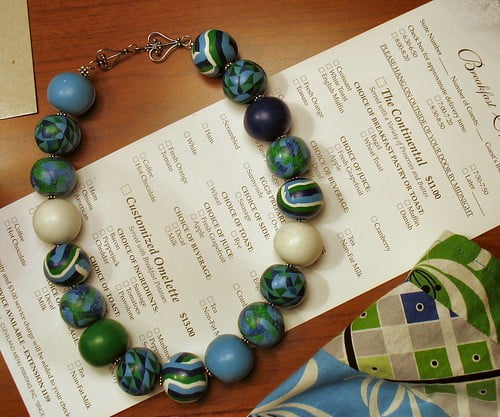
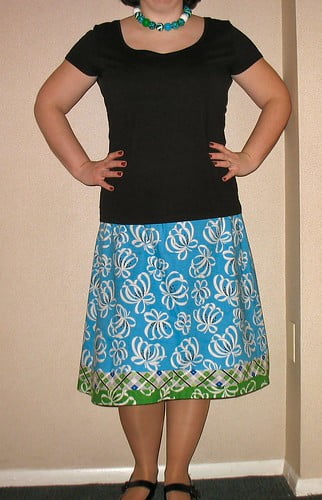
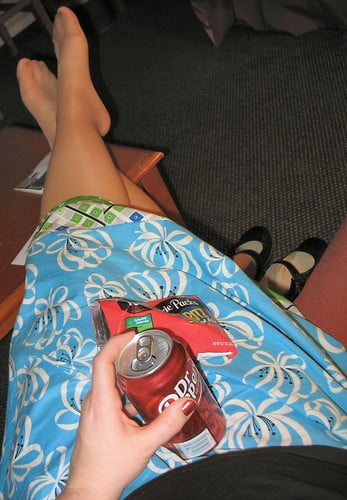
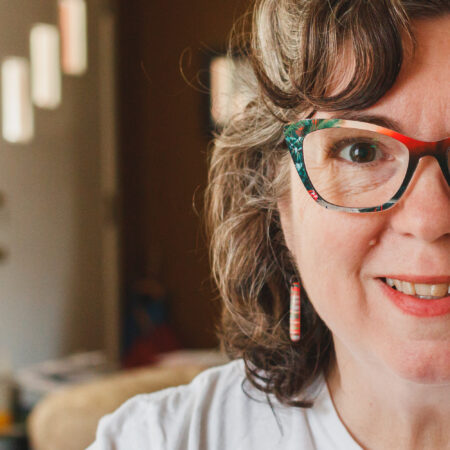
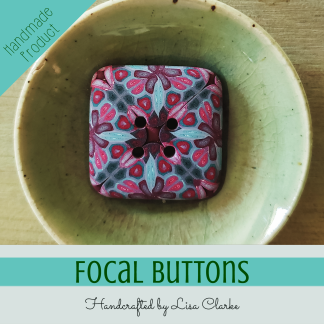
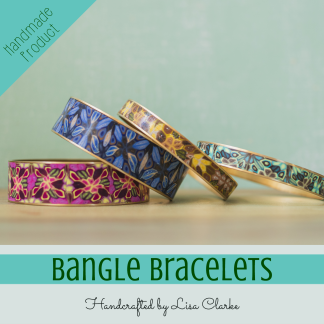
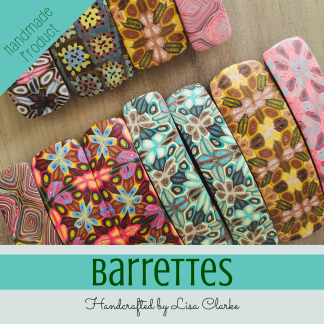
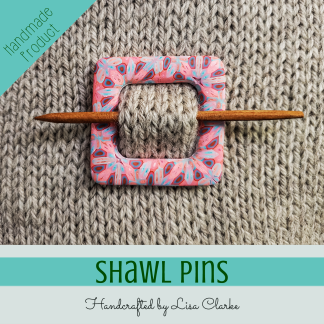
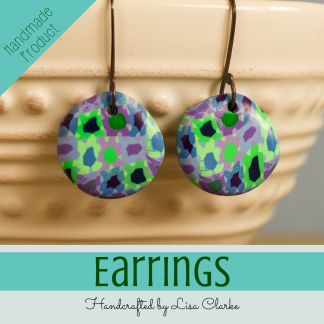
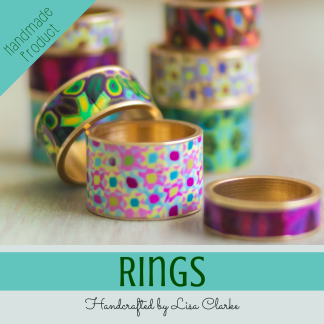

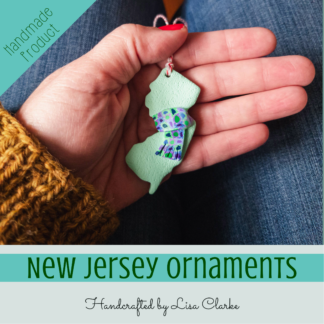
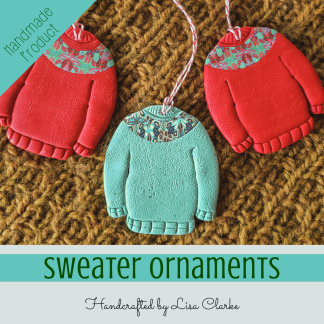
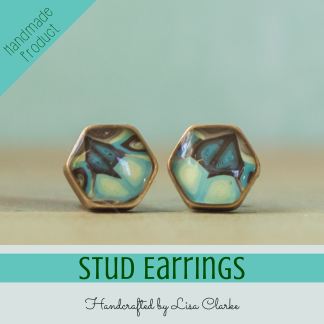
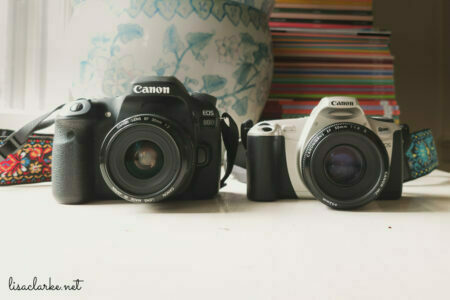













The point was made that a piece can be a gorgeous, impeccably finished piece, but if it doesn’t have something to say, it falls flat.
That sounds like a load of BS that someone made up to justify charging more for their work. I dunno, you’ve posted pictures of other people’s clay work before (like the earrings in this post), and I don’t think they “say” anything. They’re pretty, sure, but if they’re supposed to tell me a story, it’s not working. Or maybe you have to be more sophisticated than I am to “get” it. I don’t know if I buy that.
I think I probably misquoted the point I was trying to get across. I didn’t mean that art has to tell a specific story so much as have a “voice.” There’s a difference.
My trouble is that I don’t really know how you can make a piece with exquisite craftsmanship that doesn’t have a voice, or doesn’t jump out and grab someone. It seems to me that a well-made piece is going to do that by default. Which is why I am confused 😉
On the idea that a piece of craft or art has to have a voice, no, I don’t think it has to have one that you can particularly identify. I mean, after a certain amount of time – and by time I mean those first few dozen or hundred pieces not 1 year or 5 or 10 – everyone’s work has a style that is somewhat identifiable. And style is the start of the voice.
So, a lot of my pieces have my style and that is sort of the muted voice. Very few of my pieces are what I’d call ‘Art’ but I do now have a few and they they do all have a little more to them (call it a voice or story) either because they were a buttload more work or because I made them more involved than they should be or what not.
Do I think I would eat regularly if I had to rely on selling only my art rather than my artisan / craft pieces? No, I don’t. I have been a working artist – graphic arts as well as clay arts – my whole adult life and I have rarely stopped to consider what this piece said but I also don’t sell on the gallery circuit.
See what Elaine has been blogging about: More Experimenting
Yeah, I don’t sell on the gallery circuit either. And at this stage of my life, I don’t really know that I want to. Like I said in my reply to Diana below, the more work you put into a piece to elevate it to art, the more expensive it has to be. You run the risk of pricing yourself right out of the market that you are comfortable in.
Right now my sales are mostly word-of-mouth around town, and a couple of local vendor/craft fairs. These are not opportunities to sell $100 earrings. But pretty things that are affordable? Yep, they sell.
You’ve gotten a stack of impressive comments since my reply to your post and I have to say that in itself is a sign of the times and changes in even this, the discussion of art, craft.
When you can take the discussion home and extend it in an honest voice to your peers, your customers and a further audience and have some of the current Big Voices in the field answer, it’s interesting. It moves the discussion of Art out of the gallery and classroom and stuffy wine and cheese environment into a place that is visible and easy to access.
I also appreciate that everyone has said some of the same things but that every single poster has had a different take on your original post, even the ones who heard or were closer to the initial session. It is like the game of telephone as Seth said.
See what Elaine has been blogging about: More Experimenting
Lisa, IMHO polyclay art/crafts boils down to the same thing as writing fiction (my personal forte): in the end it’s all about taste. People like what they like. The distinction between “art with a voice” and “pretty” doesn’t really matter at the end of the day because people want, buy, and treasure whatever it is that they LIKE.
I have to tell you, it blows me away reading about you all in awe of these polyclay artists and feeling outclassed by them, when from my perspective you are in the same category as they are! 🙂 But I guess a mark of being good at something is admiring others who do what you do and being humble about your own skills.
Thanks, Diana, that is really nice to hear you say!
I think that seeing polymer clay pieces in person is an eye-opening experience. Sometimes the photography doesn’t do them justice. And other times the photography makes them look much nicer than they really are… I’ve seen some work that completely surprised me in how unappealing it was in person.
I guess my point is that a photograph of my earrings next to a photograph of Julie Picarillo’s earrings would put them in the same class. But when you feel them in person, you can tell that hers have been sanded ultra-smooth, and mine, while smooth, are not up to that standard. Little details like that make a world of difference in classifying something as art, in my opinion. The good news is, it would pretty much just take a few pieces of sandpaper and a couple of minutes of elbow grease for me to get to that level.
The question then becomes, do I want to? I run the risk of pricing myself right out of the market I am in, if I do that. But I suppose that’s an entirely different topic, isn’t it!?
Hmmm. I think that if it’s ART, it should not only say something, but people observing it should know what it says. So there. This is why many creative forms that were relegated to “craft” are now being hailed as art in a more approachable form. There’s a magazine called “American Craft” that I read at my local library that focuses on Craft by highly talented, artistic people. Craft is practical, useable, functional – or is inspired by such pieces. Craft can be a chair or a vase or a garment that says something about the creator’s aesthetic sense, attraction towards particular shapes, colors, materials; while it definitely expresses something, it doesn’t necessarily SAY anything. And Craft, created by artists, is, indeed, art. It’s not ART, meant to be studied and interpreted, carrying a message that must somehow be conveyed. It is Art, though, and the thing it says is “feel this texture,” “look how these colors mimic another form,” “look how a natural form created from an artificial medium makes you think about both,” or “does form follow function, or the other way around?”
An artist who feels challenged by the demand that his or her ART has to say something will definitely be happy creating ART, and insistent that if the piece doesn’t make a statement, it isn’t ART. A person who wants to make something because it calls out to be made may well be creating Craft instead of ART, but that doesn’t make that person any less an artist. If you create something because it pleases you to make it, and you use your unique skill and vision to create it beautifully and well, then that’s what it’s saying. Someone who insists that a piece needs to express an emotion, or an ideology, or make an intellectual statement might look down on a piece that says “look at the colors, the lines, the shape – check out the things I have hidden on the inside, see how different I am from different angles” but that does not mean it’s not saying anything at all.
If what you create says something quite obvious like that, it can still be art. If you want to be mysterious and enigmatic and spark discussion and debate, then you need to get away from creating functional objects, because the functionality detracts from the ART. Don’t go getting all snooty and saying that your earrings depict the struggle between the elite and the bourgeoisie. And don’t get all snooty that since the earrings don’t depict the struggle between the elite and the bourgeoisie they’re not really art.
So, Lisa, if you create something, and it says that you love the colors, it’s art. If it says that you were inspired by a shape or a shift of light, that’s what your art is saying. The message doesn’t have to be of monumental importance, it just has to be of importance to you. (I also think that if the only one who gets the really truly important message of the piece is the person who created it, it’s pretentious to call it art because it has a message. That might be just me, though.)
I’ve had more time to think about what I wrote and what I actually meant when I wrote it, and I think what you said fits in neatly with what I was actually asking. (Did that sentence make a lick of sense?) If you see my reply to Seth’s comment below, you’ll see what I said about the WOW factor and how that is really the question I was trying to ask.
I have a tendency to lump Art and high-end Craft into the same category. For me the art-vs-craft argument is not as relevant as the art-vs-not art argument. I think you answered that in a way that I can wrap my brain around 🙂
I don’t know much about the art vs function debate, since most of the things I make have their roots in functionality, but I do know that I love that skirt! 🙂 Nice fabric combo and beautiful colors!
Thanks! One of the things I like about having learned to sew recently is that I finally can make functional items. I’ve been making jewelry for so long, it’s great to have the ability to make clothing and things for my home. I’m really enjoying that. I don’t consider the functional items I make to be art, but maybe that will change once I’ve mastered the technical skills. Right now I’m still experimenting, learning and feeling my way.
Lisa,
I’ve had a few more hours of sleep and feel like I can be a little more coherant this morning than I was the whole weekend. I was so happy that you decided to come to Synergy. I think you have a perspective on juggling a business, family, art and life that was missing at this conference. One of the suggestions to improve the conference was more time for that connection around the tables. Maybe set up table topics with a moderator who has a insights on a topic that an attendee is struggling with. You would honor us to consider heading one of those tables and I’m sure it would be full, as I stuggle everyday with those issues and never manage to have the smile or positive outlook that you maintain.
You have a great friend in Alison (comment above) I wonder if she’s available for the next conference too? Inspiring thoughts.
Sorry your hotel was crappy, we are working out the bugs on many things for next time. To paraphrase Seth (I heard it was Seth, I didn’t get to hear that seminar….”throw out all the things that you don’t like or didn’t work and what you have left could be quite good….)so that’s what we’ll be digesting for the next few weeks.
fondly, Judy Belcher
Judy, it was great to meet you this weekend – you and the rest of the team did an amazing job! The hotel issue was a minor one for me, and completely worth the lousy decor and lack of natural lighting for the opportunity to spend three days soaking in everything I soaked in!
I would love to be involved in some informal discussion groups next time around. I think that’s an excellent idea. There is a whole faction of people who are not professional artists, but who would either like to get there someday, or would like to simply be “more artful” in their work. I think people like that (like me!) may have slightly different needs than those who are making a living off of their art.
Everything I heard this weekend was valuable to me. Even the things that didn’t particularly apply to me at this time in my life got my wheels turning in one way or another. I’m still digesting. And unpacking 😀
I have to admit that I often don’t get what the artist is trying to convey. Something about a piece will catch my eye and I either like it or I don’t. I do recognize the “voice” of some artists, but many I don’t.
I think it is true that something can be meticulously finished, well thought out and not be art. I think of some of the art pieces that I stand in front of and am totally clueless as to why it would be in a muesum. It looks like a pile of trash to me; I don’t get its meaning. To me is it not art, but it obviously was to someone. But a fine piece of handmade furniture, jewelry or other crafted piece connects with me even if it isn’t considered art.
Maybe most of it is in the eye of the beholder.
It was really nice to meet you at Synergy. Thanks for taking the time to chat.
Beth
It was nice to meet you, too, Beth. I’m glad you wandered over and introduced yourself.
The more I inch myself into the art world, the more I am able to understand the technical dexterity and the skills that are required to create artwork. I’m becoming more willing than I used to be to accept an item as art, because I am learning what went into the creation of it. But what I heard this weekend was that technical skills ad craftsmanship are not enough. There has to be a WOW factor. And if that is true, it seems a very subjective thing to me.
[…] I had my way, I’d spend this evening responding to all of your thought-provoking comments on my post about art, reading some of the other Synergy commentary popping up in blogs today, and slurping brownie […]
First of all, I love your skirt. Second of all, I love your necklace too. 🙂 I don’t think art needs to say something. Oftentimes I let a fabric tell me what it wants to be. I think if it’s made with love and passion, then it’s already spoken. I think that is true art.
See what Stephanie has been blogging about: Every briefcase should be pink with polka dots
Thanks, Stephanie, on both counts 🙂
That’s an interesting point about letting the material tell you what it wants to be. I’ve had that happen with clay. Sometimes it’s a rousing success and sometimes… well, we don’t have to talk about those times, LOL!
I went to an art lecture at the college I work for a few weeks back, and there was some discussion of a shift in the early-mid twentieth century art world, whereby art is no longer in the eye of the beholder, or the critic, but the artist. That is to say, not every piece of art will be pretty, or even interesting, or connect with every person, or connect with any person, but if the artist claims it as art, it is art. Unsurprisingly, there was no discussion of polymer clay, but there was discussion of Jackson Pollack and also of an artist who just installed urinals in a gallery. Not my thing, but it doesn’t have to be.
I like that view myself.
I think sometimes art is more interesting if it Says Something. I also think sometimes it’s more interesting if it intrigues me into thinking differently about color, or light, or pattern, or technique (which a lot of yours does, btw). I also think sometimes it’s more interesting if it’s just really sparkly, because I’m shallow that way.
But in the end, even if it does none of those, it’s the artist’s call.
Heh, I can relate to being shallow that way myself. That’s really what prompted this discussion. I make what I make because I like to and I like the way it looks. If it has a voice at all, it’s the voice of the work-at-home mom who needs a way to express her creativity. I get twitchy if too much time goes by and I haven’t made something.
But is that art? Beats me. I’m inclined to say “no, but with a little more effort it could be.”
Thanks for the complement 🙂
What a wonderful discussion. I think there are two tracks of classification: Art v. Craft, and Art v. Not Art.
Art versus Craft is the distinction that Alison made above. It has to do with form and functionality. It’s useful in art shows, art history classes, and auction catalogs.
Art versus Not Art is what we’re talking about here: a much more organic and human perspective that is mostly about artist and audience. The question is who decides what is Art and what is Not Art. Unfortunately, some people confuse the question of “does this piece say anything worthwhile” with the question of “is it art.” I’ll try to sort this all out below.
The reason art is tricky is that BOTH the artist and viewer can infuse art with meaning, and art has a neat propensity to evoke human emotions and thoughts. At a very fundamental level, art is just an arrangement, sometimes a manipulation, and sometimes just a recognition, of materials. Then damn it if we humans don’t muddy the waters with our own interpretations, and based on those, our own conclusions about its “art” status!
So who decides whether it’s art? The artist. My friend Lucy, who brought me into this discussion, makes a very good point that art is the artist’s call. It is like the way the IRS treats churches: for purposes of determining what is a (tax exempt) church, it takes the word of the entity that is declaring itself a church. See the Church of Craft, for example, which is applying for 501(c)(3) status as a church, citing its “religion” as crafts. Anyway, just as the IRS isn’t — and can’t be — the religion police, the art-beholders aren’t the art police. So, art is art if the artist says so. Period.
Now there’s the question of meaning — of the art’s message. That’s where both sides can participate. First, the artist has a lot of techniques to give her work a specific meaning if she wants, either explicit or implicit or somewhere in between. If she wants, she can use recognizeable symbols, like the written word or common images, to get something specific across to the viewer. Or she can “say” something that not everyone is likely to get: like the experimental use of of a round canvas and one color of paint. Or she can say absolutely nothing, and just indulge her hands in the pleasure of playing with clay.
On the viewers’ side, the aesthetics of color, texture, form, images touch something human in them and end up making people like art, relate to it, become inspired by it, and allow it to “tell” them things. As beholders experience the art, they come up with their own thoughts, or think about things they wouldn’t have had occasion to think of before. If the artist has “said” something explicit, they will get it — maybe. Or they might misinterpret her or come up with an interpretation that she would agree with but hadn’t thought of. In any case, art’s impact has at least as much to do with the beholder as it has to do with the art.
So to summarize, art is art if the artist says it is. Whether it “says anything” is debatable and is up to both the artist and the viewer. If an earring you make delights you, then it’s speaking to you. As an artist, you don’t have to try harder to make it talk. If you look at Jackson Pollack’s work and say, “he really had a neat idea to shake things up. And aren’t those splash-shapes interesting?” then his painting is speaking to you. Jackson Pollack seemed to want to make a statement, but even if he hadn’t, people would still have had their visceral reactions. If you make fifty matching sculpey pins, they might have the effect of a fabulous 50-voice choir, or they might be a collection of really quiet individual voices saying something insipid in almost-synchronicity. Again, depends on the beholder, but hooray for the artist who makes them!
In my case, I am an artist, so I make art. Whenever I sit at the table I try to make shapes with my wadded up paper napkin. When thinking about what color to paint the shed, purple polka-dots come to mind. Somehow my being has compelled me to make more Halloween costumes, from an earlier age, than most people. My compulsions result in art, whether it’s any good or not, and regardless of whether anyone ever sees it. Usually on the art/not art continuum, stuff I put my hands on ends up on the “art” side.
I also happen to make a specific kind of art, as my career, that tells stories fairly explicitly, but which also lets the viewers infuse their experiences of the art with their experiences of the story. I make custom art-quilts using photographs of people’s loved ones and homes, and using fabric from their old clothes or blankets. I absolutely love making art that has a strong personal meaning to one finite set of viewers.
I don’t know where my art-quilts and pillows would fall in the Art v. Craft continuum; my techniques aren’t that impressive, and the work is arguably functional. Ordinary passers-by would probably not want most of these objects in their living room. Art specialists might not consider it all much of a contribution to the Academy. But this is why do it, and why I think it is important:
– I made a quilt for a little girl whose father had died in the military, using his t-shirts. The deceased man’s dad wrote me a letter to tell me how much it meant to him and his whole family.
– A woman bought her grandmother-in-law a pillow with pictures of the recipient and her late husband, along with pictures of the rest of the family looking happy and young. The grandmother loved the pillow so much that the family buried her with it when she died.
– A woman commissioned a quilt for her lesbian partner, using significant images from the partner’s life. The partner took the quilt with her to show her parents on the weekend she came out of the closet to them, to show how much her girlfriend knew her and loved her.
– A husband was going to be transferred to another state for two years for work, so his wife had me make him a pillow with a picture of their dog and cat on it. As a cat-owner, I can imagine that that would give him some real comfort during his lonely two-year stay.
And in conclusion, I should also say that making quilts is not as lucrative as making money, so I have a day job. And I should go back to it. It’s been fun, guys.
Wow, Kay, a lot to chew on there!
So let’s assume that Art is Art if the Artist says it is. That makes it tough on those of us with no formal art training, who haven’t had any kind of art class since 8th grade, who know nothing about design, and who just like to make things. Those of us who were lucky enough to be born with an intuitive sense of color and form are probably qualified to make that call. But those of us who really don’t have the color thing down, or who don’t understand what makes a piece appealing – can they really call their creations art and be right?
I suppose that’s somewhat off of the topic at hand, but it’s what first occurred to me when I read your comment. In answering the “what is art” question in that way, it seems to me that you create a new question: “Who is an artist?”
I’m glad Lucy invited you to the conversation. It’s nice to “meet” you!
Oh, dear, yet another designation for putting people into the “art” camp or the “the other stuff” camp…
Seems like there’s always someone telling us what the real deal is. Some people think if you make art purely for art’s sake, without putting a price on it, that’s “real art.” Others think if you have to get serious and put food on the table with it, that’s “real art”. Or if you only have to please yourself, that’s “real art”. (Never mind that most of the art we think of as “real art” was created to spec, with a studio full of assistants, for wealthy patrons…) There’s plenty of competent-but-not-exciting work that consistently gets the awards and the oohs and ahs, and there’s plenty of fabulous work out there that never quite fits into the awards categories…
And no matter where we find ourselves on the spectrum, if feels like there’s someone at the other end claiming that their end is better.
Re: The idea that art has to have a story, I wasn’t at the conference (drat!) and can’t speak for what was said there. But I’m guessing it’s not an individual PIECE that has to have a story (though that’s cool, too.) It may be that when we imbue our body of work with OUR story, it gets more powerful.
No matter how instinctive and intuitive, or deliberate and academic our approach to art/craft is, the more we understand where it’s coming from inside us, the more articulate we can be about it. And the more articulate we can be, the more powerful it gets.
Lisa, when I talk to people about the “story” in their art, I mean the story that is in their HEART. I call it the big WHY. Why do YOU make it? Why do you do it the way YOU do? Why is it unique to YOU? Why is it important to YOU?
When we dig a little deeper to find that WHY, we find that giant watch spring that drives our entire creative process.
When I’ve questioned people (okay, I leaned on them!) to get to the WHY of their work, there is always–ALWAYS–a powerful story there. No matter how simple, it was what was in their heart that came out in their work.
So maybe your work is just for fun. “Fun” is great! But consider this–if your life is hectic and full of taking care of everyone else, then that little bit of space you carve out to have fun becomes more poignant and meaningful. Sometimes the simplest things we do have more meaning and impact that we can imagine.
Once you recognize that and articulate that to your audience, it gets a little bigger somehow. Instead of JUST “fun”, others now think, “That’s MY life, too! And if I buy a little piece from her, it will remind me how important and precious that notion is. It will remind ME to do the same…” One customer will buy it because it’s just plain cute and fun. But another customer will now look, too because it says something to her.
I hope I haven’t muddied the water or rambled too much. I believe if your work gives you joy and gives others joy, then that’s just about as big as it can get. There’s room in the world for ALL our art. If everyone were working at their heart’s content, maybe there would be a little less darkness in the world.
Thanks for jumping in, Luann. I enjoy your blog and your perspective.
My involvement in polymer clay comes from the fact that I enjoy it. I make it for me first, and if I can sell some of it, all the better. I do it to relax, and I enjoy it because I think I’m pretty good at it. I certainly have room for improvement in terms of my craftsmanship, but I really only feel the need to develop that side more if I am going to try and sell in high-end markets. For me, for now, what I make satisfies my need to create, my desire to make things I can wear, and my occasional craving for positive attention from outside sources. That’s what my story is, and I suppose there are a lot of people out there who could relate to that.
OK it seems we are playing a game of Telephone here. I was a presenter at Synergy and was one of the people speaking about finding ones own voice. I just want to make it clear that There was no talk about art vs. craft or who was an artist or who was not an artist. What I and many of the presenters were speaking about was that the work that wows, the work that catches the eyes of the jury panel or collectors is the work that has a clear strong and consistent imprint of the maker.
I can’t speak for every presenter or session as I was not at every session but I can say that at my sessions and the ones I attended the talk was about the work having a voice. The artistic voice of the maker, what I call creative authenticity . There was no talk about work having to have a message or having to tell a story. There was no one saying that only pieces that had a deep meaning we worthy of being call art.
On a Side note, if anyone is interested in the question of Art VS Craft I would recommend reading: A Theory of Craft: Function and Aesthetic Expression by Howard Risatti. I would love to start a discussion based on what Mr Risatti lays out in his book.
A game of Telephone. That’s a good way to put it. I am pretty sure I am at least partially to blame for blogging at 1:30am and poorly articulating what I meant to get across.
When I referred to art having “something to say” I didn’t mean that it needed to have a specific message or tell a particular story so much as that it needed to “speak” to the viewer on a deeper level than “oh, that’s pretty.”
I’m still not sure I’m explaining it properly. I guess what I am wondering is how can something be expertly-crafted, impeccably-finished, embracing many of the principles and elements of design, and still not be considered art? Where does that WOW factor come from, if not those things?
I think it was Robert Dancik, standing up from the audience during the first panel discussion on craftsmanship, who made the comment that first got me thinking. I wish I could remember his exact words.
Thanks for stopping in and helping me figure out how to clarify what I was trying to say! And thank you for the book recommendation.
Lisa, this is an excellent topic and it’s become quite an interesting discussion. I think it depends, like so many other things in life, on each individual’s perception as to whether or not something speaks to them or evokes some sort of emotion. Art is purely subjective and the process of creating is not a static one. If we choose, we have the power to improve our pieces by studying design or color or mastering a new technique or improving our finishing or a thousand other things.
It seems as if what’s most important is that we take pleasure in the process of creating things that we’re proud of. Not every pair of earrings has to be “art”. They can just be a nicely made pair of earrings that you feel wonderful wearing and that’s okay. I think the WOW factor that you spoke about comes from a number of things – good craftsmanship, excellent design, good color sense, innovation, mastery of material, etc. AND our own unique perception of what we consider these things to be. What WOWS me may not necessarily WOW you. So, I guess what I’m trying to say is that the WOW factor is just as subjective as anything else.
All of us, from the timid beginners to the most accomplished and pompous egomaniacs can count on one thing. . . not everyone is going to like and/or appreciate what we’ve created.
Just for the record, I think you do have a style and I see your “voice” coming through in your art. It’s fun and colorful and wonderful. If you feel as if your finishing could be better, that’s an easy thing to change, just as you said.
Sometimes I think the whole art thing is taken WAY too seriously. Whether you earn a living at this or not, you can’t lose your perspective on what it ultimately is : a means of personal self-expression. I have a huge appreciation for beautiful and well-made things but realistically, none of that is going to cure cancer or feed multitudes of starving people or solve the healthcare crisis in our country. It’s just art. My all time favorite quote from Picasso:
“Art washes away from the soul the dust of everyday life.”
If that’s how the creative process makes you feel, then you’re doing something right.
See what Kim Cavender has been blogging about: I’m off to get SYNERGIZED!
Good point, Kim – in the grand scheme of things, who really cares what we call it? It’s serving a purpose of self-expression for the person who creates it, and bringing beauty to those who appreciate it.
And you know, I think you are right about my voice. The more we all chat about this issue, the more I’m starting to realize that what I have been referring to as “finding my niche” was really the point in my work where my voice began to come through.
One of the things I’m thinking I need to do is brush up on the lingo. I got a bit of a start with Julia Sober’s seminar on design, but I’d like to learn a little more. Conversations like this would be a lot easier with the right vocabulary!
[…] Lisa on PolkaDotCreations here and here […]
Leave it to Kim to beat me to it! By the time I read through all these comments, all I wanted to say was, you do have a voice. Your work is dsitinctive. You are inspired by the fabrics, or color palettes. How you then interpret that inspiration is distinctly YOU!
Whether or not your work is finished and refined to the nth degree, that is another question, seperate from voice. And, your insight as to whether the market you have built for your work will want to pay for the added labor that might be involved is a good one. We all need to look at those tradeoffs for the choices we make for our business.
There are many possible models for being a working artist. Sometimes it does not even involve selling your work. The best one, is the one that best fits your life and your skills and interests. The model that Kathleen Dustin, or Christie Freisen, or Judy Belcher follows are all unique to them and what they enjoy. The gold standard is not one model. The gold standard is what works best for us. If we want to do certain shows, or have our work in certain galleries, there are expectations about workmanship, design, etc. But not everyone can, or wants to follow that path. Getting into a show like the Smithsonian Craft Show is tougher than getiting into Harvard. But there are plenty of other ways to find a way to integrate craft into a person’s life and fulfill that need to create something beautiful.
See what Judy Dunn has been blogging about: Owning Up
What a great response! I’ve always felt a little outclassed in art-related discussions, mainly because I am not aiming to sell in museums or high-end craft shows. Rarely is it considered just as valid to choose a less “prestigious” market, or to choose not to sell at all. I like your perspective on this. It makes me feel a little less ill-equipped to consider myself an artist.
[…] noticed Susan talk about it over at Polymer Clay Notes earlier this month. In light of all of our recent chatting about artsy things around here, I thought it might make for a good addition to the […]
[…] page 427 ! of her Polka Dot Creations blog Lisa Clarke has posted her observations and […]